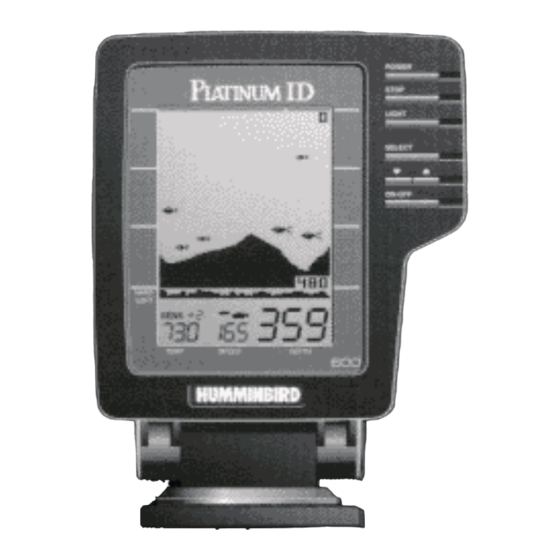Table of Contents
Advertisement
Advertisement
Table of Contents

Summary of Contents for Humminbird Platinum ID 600
-
Page 2: Transducer Mounting Procedure
Please carefully consider the following before installing your transducer. TRANSDUCER MOUNTING OPTIONS A. Transom Mount- The Humminbird high speed transducer allows the transducer element to be mounted below the bottom of the boat hull keeping the transducer out of turbulent water and... - Page 3 B. Inside Hull Mount- The high speed transducer can be mounted inside the hull (without pivot assembly) using the proper two-part epoxy, such as Humminbird’s epoxy kit. Even though there is some loss of signal in shooting through the hull, your LCR will perform well with this type of installation.
- Page 4 Once the location is determined mark and drill three 7/64” dia.. holes noted on the template. Attach the metal bracket using three #10 self threading screws supplied. Be sure to align holes in the center of the Bracket slots. On some aluminum boats it may be necessary to use a wood back-up plate. It is important to use a silicone sealant between the screwhead and bracket in order to prevent leaking.
- Page 5 NOTE: On boats with more than 15 degree deadrise angle it may be necessary to mount the transducer slightly off parallel with the water level. (See Figure E) Mark and drill the three 9/64” dia. holes as shown on the template. Attach the metal bracket using the three #10 self threading screws supplied.
- Page 6 Step 4 TRANSDUCER ASSEMBLY- Insert the transducer assembly into the metal bracket from the bottom. Push up until the holes in the plastic pivot align with the uppermost holes in the bracket. Slide the O-ring on to the headed pin and insert it through the two parts. Assemble by screwing the ¼”x3/8”...
- Page 7 Techsonic Industries, Inc. will not be responsible for any damage due to the mounting of your transducer in this manner. NOTE: An Epoxy Kit (Part N. EPK) is available from Humminbird. This Epoxy Kit has been formulated for Inside Hull Transducer Installation.
- Page 8 Position the swivel base and drill four ¼” diameter holes. Note: The LCR hole pattern Is the same as for all Humminbird flasher units. Use hardware provided to mount this base to the boat. Next place the gimbal bracket on the swivel base and attach with four small machine screws, provided.
- Page 9 Install the mounting knobs and tighten snugly. The unit can now be swiveled and tilted to any desired position.
- Page 10 INSTALLING THE CABLES Your LCR comes equipped with Humminbird’s new Angle-Lock power and transducer connectors. The power connector is identified with the letter P on the back of the plug.
- Page 11 It plugs into the outlet on the back of the unit marked “Power”. The transducer connector is identified with the letter T and plugs into the outlet on the back of the unit marked “Transducer”. Note: An adapter (AD-4) is available to allow use of an old waterproof (BNC) transducer with the LCR, but be sure that the transducer is a 16degree.
- Page 12 NOTE: If other problems occur, see "Troubleshooting" later in this manual for tips from the Humminbird engineers. If you don't find the solution there, call our Customer Service Hotline. USING THE PLATINUM ID This section provides complete information on operating the Platinum ID through its front panel controls.
- Page 13 USING THE BUILT-IN SIMULATOR The Platinum ID includes a built-in simulator that helps you learn to use your new equipment. The simulator displays a typical underwater scene, and lets you practice with the controls. The unit must be turned off before you start the simulator. To activate it, press down and hold the POWER button until a chirping sound begins.
- Page 14 The three position bottom hardness scale at the bottom of the screen helps differentiate between grass or muddy (soft) bottoms and structure or rock (hard) bottoms. After you adjust any function, the display returns to its full-screen reading. If the menu doesn't stay on the screen long enough, press the STOP button to hold the menu on the screen.
- Page 15 ID identifies targets not attached to the bottom and displays them with either a fish symbol or an arch. Three different size symbols are used to represent the returned signal strength, a good indicator of fish size. Use the up and down arrow keys to switch between fish or arches, or use the ON-OFF key to disable ID.
- Page 16 4. Enabling Bottom Alarm; Factory Setting: OFF The Bottom Alarm lets you specify the minimum depth you want to maintain. To use it, select BOTTOM ALARM; then press the ON-OFF button to activate the alarm, and the UP or DOWN arrow button to adjust the depth at which the alarm will sound.
- Page 17 6. Using Zoom Range; Factory Setting: OFF Zoom Range provides an up-close view. To activate it, select ZOOM RANGE and press ONOFF. The Zoom view begins initially at the surface; press the UP or DOWN arrow to adjust Zoom depth. The range of the display is shown when Zoom is on.
- Page 18 8. Setting Display Speed; Factory Setting: One level below maximum The Platinum ID display is "updated" (advances across the screen) as you move through the water. The speed at which the display is updated depends on the Display Speed setting. To adjust it, select DISPLAY SPEED, and press the UP arrow button for a faster setting or the DOWN arrow for a slower setting.
















